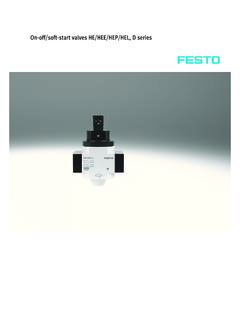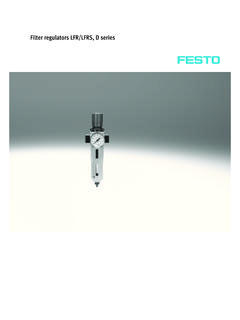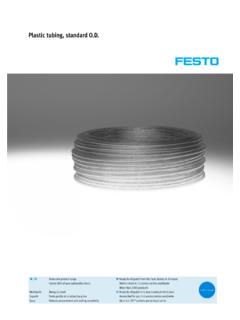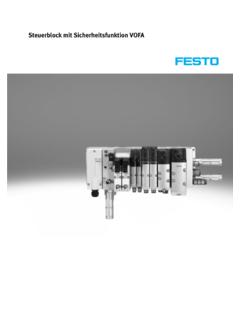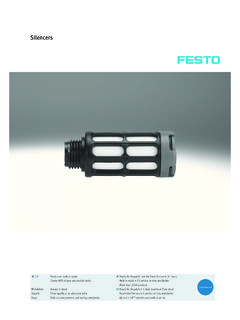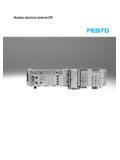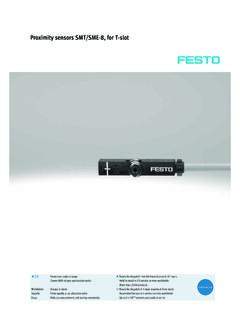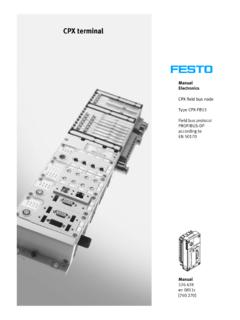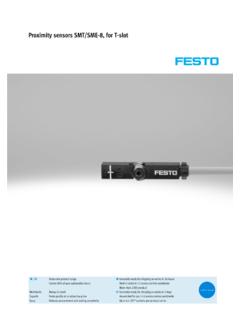Transcription of Basic Vacuum Technology Principles - Festo USA
1 Subjecttochange1 Internet: Principles of Vacuum Technology , brief overviewIntroductionBasic Principles of Vacuum technologyWhat is a Vacuum ? Vacuum rangesUnits of measurementA Vacuum is a space entirely devoid ofmatter ( absolute Vacuum ).In practice we talk about a vacuumwhen the air pressure in a space liesbelow atmospheric [pa]P[mbar]There are a large number of nationaland international units ofmeasurement. The most commonlyused units are Pascal (Pa) and bar100Pa =1hPa1hPa =1mbar1 mbar = barThe Vacuum level is often expressedas a % value.
2 However, these arealways relative = Rough vacuumFV = Medium vacuumHV = High vacuumUHV = Ultra-high vacuumWhat is a Vacuum used for?Measuring the pressure or vacuumAtmospheric pressureThe Vacuum plays a vital role inresearch in the fields of chemistry,biology and is also indispensable in manyindustrial the rough Vacuum range, thepressure gauges used are mainlymechanical, but some digital pressuregauges are also the high and ultra-high vacuumrange, highly sensitive pressuregauges are [km]p[hPa]
3 1 Mount Everest2 Festo3 Sea levelUnderstanding vacuumVacuum specification optionsEffects of changes on per m3of air at one barair exert pressure or force on thewalls of a defined space. The fewerparticles there are in the space, thelower the force exerted on the Vacuum can be specified as anabsolute value, with a positivesignfrom1to0bar,with0asabsolute zero. Or it can be specifiedas a relative value with a negativesignfrom0to 1bar,with0asareference point, or as a %.As altitude increases, the air pressurein the atmosphere falls.
4 This sameeffect reduces the attainable vacuumlevel of an ejector. Nevertheless, theperformance level of 80% remainsunchanged in this Vacuum would mean that thereare no particles present. Pressure = Internet: Principles of Vacuum Technology , brief overviewIntroductionComponents for Vacuum generationVacuum ejectorsDisplacement Vacuum pumpsKinetic Vacuum pumpsThese function according to theventuri principle, they are drivenpurely pneumatically and have amuch simpler design compared withother Vacuum flowing into a space ismechanically shut off, compressedand ejected.
5 This allows a very highvacuum to be achieved at a very lowflow is forced to flow in the deliverydirection through the application ofadditional mechanical force. Thismethod achieves only a relatively lowvacuum level despite a high The most important componentsare the jet nozzle (venturi nozzle)and at least one receiver nozzle. Acceleratedcompressedairgenerates a suction effect betweenboth nozzles ( Vacuum ). There are different designprinciples: single-stage and multi-stage ejectors. Depending on the principle, air iseither carried away in a flow by arotating impeller on the suctionside or compressed using vanedchambers.
6 The pump types availableinclude Vacuum blowers andvacuum compressors, for side2 Suction side3 Inlet valve4 Exhaust valve5 PistonFeatures High Vacuum level with relativelysmall flow rate Maintenance-free and wear-free Low-cost Low-weight, compact design Any mounting position High Vacuum level up to baroperating pressure Minimal maintenance expenses Generally large dimensions andhigh weight Restricted mounting position Large flow rates, low Vacuum level High maintenance costsApplication Wide range of applications, handling Technology andprocess engineering.
7 Broad application spectrum inindustry and research. Used mainly for precision processesin Internet: Principles of Vacuum Technology , brief overviewIntroductionVacuum in handling technologyPractical use of vacuumImportant selection factorsBenefits of a vacuumTheextensiverangeofvacuumcomponent variants makes them idealfor use in many Weight, temperature, shape androughness of the workpiece surface Speed per unit of time Stroke travel and conveyingdistances Gentle handling Compact, low-weight, space-savingdesign Fast cycle times possible Low maintenance costs Low-costComparison of ejectorsVariables/criteriaSingle-stageMu lti-stageSuction flow rateAverageHighAt low Vacuum level up to approx.
8 50%Evacuation timeVery shortIn higher Vacuum range from 30 .. 50%Very shortIn lower Vacuum range up to 30 .. 50%Initial costsLowRelatively highNoise generationRelatively highLowBoth Principles have their advantagesand disadvantages which are difficultto compare. With optimally adaptedcomponents, both Principles cancoveralargenumberofdifferentareasof comparison variablesEvacuation timeAir consumptionEfficiencySuction flow rateEvacuation time = Time (s) required togenerate a specific consumption = Air consumption(l/min) of the ejector required togenerate a specific efficiency formula makes it easierto compare the different Principles .
9 Efficiency = Evacuation time, airconsumption and volume dependenton efficiency of an ejector is often and incorrectly measured using thesuction flow rate at 0 flow rate = Suction air volume(l/min) that an ejector can draw Internet: Principles of Vacuum Technology , brief overviewIntroductionVacuum in handling technologyEnergy cost comparisonTo generate compressed air fromatmospheric air, you need to reckonon approx. per m3volume at7 bar pressure when calculating thecosts involved ( investment,material, labour, etc.)
10 Vacuum ejectors: High air consumption, butcompensated by its energy-savingfunction Maintenance-free, no moving parts Low weight and componentdimensions and can be installed inany mounting position No electrical connections required Relatively high Vacuum level (up to85% Vacuum ) attainable Low initial costsElectric Vacuum pumps: Very high Vacuum (up to )attainable High suction rates ( Vacuum blower)of up to 1,200 m3/hr. possible High current consumption becauseof continuously operated pumps High initial costs and ongoingmaintenance costs Largeweightandunitvolumeaswell as fixed mounting positionFor a comparison of features, acalculation example and an energycost comparison in Vacuum systemsWhen a Vacuum suction grippercannot fully seal the system againstatmospheric air, we talk about might be caused, for example.
